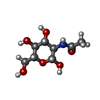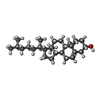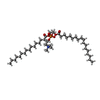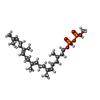[English] 日本語
 Yorodumi
Yorodumi- EMDB-46798: Human V-ATPase Vo subcomplex (containing subunit isoform a4) boun... -
+ Open data
Open data
- Basic information
Basic information
| Entry |  | ||||||||||||||||||
|---|---|---|---|---|---|---|---|---|---|---|---|---|---|---|---|---|---|---|---|
| Title | Human V-ATPase Vo subcomplex (containing subunit isoform a4) bound to nanobody and inhibitor | ||||||||||||||||||
 Map data Map data | Human V-ATPase Vo subcomplex (containing subunit isoform a4) bound to nanobody and inhibitor | ||||||||||||||||||
 Sample Sample |
| ||||||||||||||||||
 Keywords Keywords | V-ATPase / lipid nanodisc / Vo subcomplex / inhibitor / MEMBRANE PROTEIN | ||||||||||||||||||
| Function / homology |  Function and homology information Function and homology informationproton-transporting two-sector ATPase complex / Ion channel transport / Regulation of MITF-M-dependent genes involved in lysosome biogenesis and autophagy / renal tubular secretion / intracellular pH reduction / plasma membrane proton-transporting V-type ATPase complex / eye pigmentation / central nervous system maturation / ATPase-coupled ion transmembrane transporter activity / rostrocaudal neural tube patterning ...proton-transporting two-sector ATPase complex / Ion channel transport / Regulation of MITF-M-dependent genes involved in lysosome biogenesis and autophagy / renal tubular secretion / intracellular pH reduction / plasma membrane proton-transporting V-type ATPase complex / eye pigmentation / central nervous system maturation / ATPase-coupled ion transmembrane transporter activity / rostrocaudal neural tube patterning / positive regulation of transforming growth factor beta1 production / Golgi lumen acidification / synaptic vesicle lumen acidification / proton-transporting V-type ATPase, V0 domain / Transferrin endocytosis and recycling / cellular response to increased oxygen levels / vacuolar transport / endosome to plasma membrane protein transport / vacuolar proton-transporting V-type ATPase, V0 domain / clathrin-coated vesicle membrane / lysosomal lumen acidification / endosomal lumen acidification / regulation of pH / XBP1(S) activates chaperone genes / proton-transporting V-type ATPase complex / Amino acids regulate mTORC1 / vacuolar proton-transporting V-type ATPase complex / head morphogenesis / osteoclast development / vacuolar acidification / ROS and RNS production in phagocytes / regulation of cellular pH / dendritic spine membrane / azurophil granule membrane / ATPase activator activity / regulation of MAPK cascade / autophagosome membrane / tertiary granule membrane / proton-transporting ATPase activity, rotational mechanism / ficolin-1-rich granule membrane / cilium assembly / RHOA GTPase cycle / positive regulation of Wnt signaling pathway / regulation of macroautophagy / transporter activator activity / Metabolism of Angiotensinogen to Angiotensins / angiotensin maturation / Insulin receptor recycling / proton-transporting ATP synthase activity, rotational mechanism / receptor-mediated endocytosis of virus by host cell / axon terminus / endoplasmic reticulum-Golgi intermediate compartment membrane / RNA endonuclease activity / proton transmembrane transport / ossification / receptor-mediated endocytosis / brush border membrane / sensory perception of sound / small GTPase binding / transmembrane transport / phagocytic vesicle membrane / apical part of cell / synaptic vesicle membrane / positive regulation of canonical Wnt signaling pathway / signaling receptor activity / ATPase binding / basolateral plasma membrane / Hydrolases; Acting on ester bonds / intracellular iron ion homeostasis / postsynaptic membrane / early endosome / lysosome / endosome / endosome membrane / apical plasma membrane / Golgi membrane / axon / lysosomal membrane / external side of plasma membrane / focal adhesion / ubiquitin protein ligase binding / Neutrophil degranulation / endoplasmic reticulum membrane / protein-containing complex binding / extracellular exosome / membrane / plasma membrane Similarity search - Function | ||||||||||||||||||
| Biological species |  Homo sapiens (human) / Homo sapiens (human) /  | ||||||||||||||||||
| Method | single particle reconstruction / cryo EM / Resolution: 3.0 Å | ||||||||||||||||||
 Authors Authors | Oot RA / Park JB / Roh S-H / Wilkens S | ||||||||||||||||||
| Funding support |  United States, United States,  Korea, Republic Of, 5 items Korea, Republic Of, 5 items
| ||||||||||||||||||
 Citation Citation |  Journal: To Be Published Journal: To Be PublishedTitle: Inhibitor bound Vo subcomplex from human V-ATPase Authors: Oot RA / Park JB / Roh S-H / Wilkens S | ||||||||||||||||||
| History |
|
- Structure visualization
Structure visualization
| Supplemental images |
|---|
- Downloads & links
Downloads & links
-EMDB archive
| Map data |  emd_46798.map.gz emd_46798.map.gz | 96.1 MB |  EMDB map data format EMDB map data format | |
|---|---|---|---|---|
| Header (meta data) |  emd-46798-v30.xml emd-46798-v30.xml emd-46798.xml emd-46798.xml | 25 KB 25 KB | Display Display |  EMDB header EMDB header |
| Images |  emd_46798.png emd_46798.png | 108.6 KB | ||
| Filedesc metadata |  emd-46798.cif.gz emd-46798.cif.gz | 8.7 KB | ||
| Archive directory |  http://ftp.pdbj.org/pub/emdb/structures/EMD-46798 http://ftp.pdbj.org/pub/emdb/structures/EMD-46798 ftp://ftp.pdbj.org/pub/emdb/structures/EMD-46798 ftp://ftp.pdbj.org/pub/emdb/structures/EMD-46798 | HTTPS FTP |
-Validation report
| Summary document |  emd_46798_validation.pdf.gz emd_46798_validation.pdf.gz | 560 KB | Display |  EMDB validaton report EMDB validaton report |
|---|---|---|---|---|
| Full document |  emd_46798_full_validation.pdf.gz emd_46798_full_validation.pdf.gz | 559.5 KB | Display | |
| Data in XML |  emd_46798_validation.xml.gz emd_46798_validation.xml.gz | 6.6 KB | Display | |
| Data in CIF |  emd_46798_validation.cif.gz emd_46798_validation.cif.gz | 7.7 KB | Display | |
| Arichive directory |  https://ftp.pdbj.org/pub/emdb/validation_reports/EMD-46798 https://ftp.pdbj.org/pub/emdb/validation_reports/EMD-46798 ftp://ftp.pdbj.org/pub/emdb/validation_reports/EMD-46798 ftp://ftp.pdbj.org/pub/emdb/validation_reports/EMD-46798 | HTTPS FTP |
-Related structure data
| Related structure data |  9detMC C: citing same article ( M: atomic model generated by this map |
|---|---|
| Similar structure data | Similarity search - Function & homology  F&H Search F&H Search |
- Links
Links
| EMDB pages |  EMDB (EBI/PDBe) / EMDB (EBI/PDBe) /  EMDataResource EMDataResource |
|---|---|
| Related items in Molecule of the Month |
- Map
Map
| File |  Download / File: emd_46798.map.gz / Format: CCP4 / Size: 103 MB / Type: IMAGE STORED AS FLOATING POINT NUMBER (4 BYTES) Download / File: emd_46798.map.gz / Format: CCP4 / Size: 103 MB / Type: IMAGE STORED AS FLOATING POINT NUMBER (4 BYTES) | ||||||||||||||||||||||||||||||||||||
|---|---|---|---|---|---|---|---|---|---|---|---|---|---|---|---|---|---|---|---|---|---|---|---|---|---|---|---|---|---|---|---|---|---|---|---|---|---|
| Annotation | Human V-ATPase Vo subcomplex (containing subunit isoform a4) bound to nanobody and inhibitor | ||||||||||||||||||||||||||||||||||||
| Projections & slices | Image control
Images are generated by Spider. | ||||||||||||||||||||||||||||||||||||
| Voxel size | X=Y=Z: 1.1 Å | ||||||||||||||||||||||||||||||||||||
| Density |
| ||||||||||||||||||||||||||||||||||||
| Symmetry | Space group: 1 | ||||||||||||||||||||||||||||||||||||
| Details | EMDB XML:
|
-Supplemental data
- Sample components
Sample components
+Entire : Vo subcomplex from human V-ATPase bound to Nanobody and inhibitor
+Supramolecule #1: Vo subcomplex from human V-ATPase bound to Nanobody and inhibitor
+Macromolecule #1: V-type proton ATPase subunit e 1
+Macromolecule #2: Ribonuclease kappa
+Macromolecule #3: V-type proton ATPase subunit S1
+Macromolecule #4: Renin receptor
+Macromolecule #5: V-type proton ATPase 21 kDa proteolipid subunit
+Macromolecule #6: V-type proton ATPase 16 kDa proteolipid subunit
+Macromolecule #7: V-type proton ATPase subunit d 1
+Macromolecule #8: V-type proton ATPase 116 kDa subunit a 4
+Macromolecule #9: Anti V-ATPase Nanobody 2CAS66
+Macromolecule #10: 2-acetamido-2-deoxy-beta-D-glucopyranose
+Macromolecule #11: CHOLESTEROL
+Macromolecule #12: (2S)-3-(hexadecanoyloxy)-2-[(9Z)-octadec-9-enoyloxy]propyl 2-(tri...
+Macromolecule #13: Cladoniamide A
+Macromolecule #14: methyl (3R,6Z,10E,14E)-3,7,11,15,19-pentamethylicosa-6,10,14,18-t...
-Experimental details
-Structure determination
| Method | cryo EM |
|---|---|
 Processing Processing | single particle reconstruction |
| Aggregation state | particle |
- Sample preparation
Sample preparation
| Concentration | 2 mg/mL | |||||||||||||||
|---|---|---|---|---|---|---|---|---|---|---|---|---|---|---|---|---|
| Buffer | pH: 7.2 Component:
Details: 20 mM Tris, 150 mM NaCl, 0.5 mM EDTA, 2 mM DTT, pH 7.2 | |||||||||||||||
| Grid | Material: GOLD | |||||||||||||||
| Vitrification | Cryogen name: ETHANE / Instrument: HOMEMADE PLUNGER |
- Electron microscopy
Electron microscopy
| Microscope | TFS GLACIOS |
|---|---|
| Image recording | Film or detector model: TFS FALCON 4i (4k x 4k) / Average electron dose: 39.96 e/Å2 |
| Electron beam | Acceleration voltage: 200 kV / Electron source:  FIELD EMISSION GUN FIELD EMISSION GUN |
| Electron optics | Illumination mode: FLOOD BEAM / Imaging mode: BRIGHT FIELD / Nominal defocus max: 2.0 µm / Nominal defocus min: 1.3 µm |
 Movie
Movie Controller
Controller





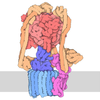

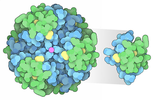

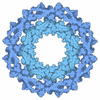
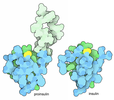


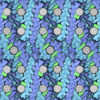
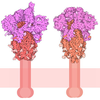
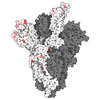
 X (Sec.)
X (Sec.) Y (Row.)
Y (Row.) Z (Col.)
Z (Col.)





















